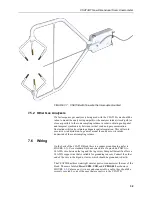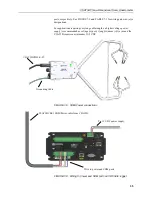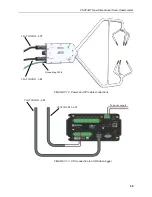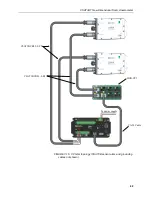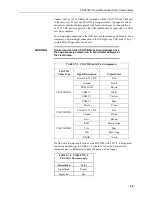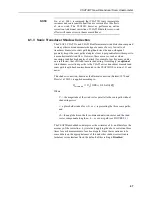
CSAT3B Three-Dimensional Sonic Anemometer
46
8. Operation
8.1 Theory of Operation
The CSAT3B uses three pairs of non-orthogonally oriented transducers that
transmit and receive ultrasonic signals. The time of flight of a sonic signal
between a pair of transducers is directly related to the wind vector component
that is parallel to the sonic axis. The CSAT3B is able to calculate the wind
vector components along each sonic axis using the time difference between an
outgoing and return sonic signal, along with the distance between sonic
transducers. Trigonometric relationships are used to calculate the wind speed in
an orthogonal x-y-z coordinate system.
The time of flight measurement is also related to the speed of sound in air,
which is a function of the air density (temperature and humidity). Through
these relationships, the CSAT3B is able to output a measurement of sonic air
temperature from which actual air temperature may be calculated if humidity is
known.
For more complete details on the theory of operation of the CSAT3B, refer to
(p. B-1)
8.1.1 Algorithm Version 5
Since the release of the original CSAT3 in 1996, various improvements have
been made to the algorithms used for signal processing and measurement
output. Each time a significant change has been made to these algorithms, a
new version number has been issued. The CSAT3B uses algorithm Version 5.
Version 5 maintains many of the advantages of signal recognition and
diagnostic sensitivity that were made possible by Version 3, while also adding
the advantages of performance during precipitation events made possible by
Version 4. It also resolves Version 4 issues of speed-of-sound measurement
errors in very high wind conditions as reported by Burns et al., 2012 (see
(p. 65)
).
8.1.2 Effects of Crosswind on the Speed of Sound
The speed of sound is found by combining the out and back time-of-flight
measurements (see Equation B-5 in Appendix
(p. B-1)
). While the parallel component of the wind along the sonic axis
does not affect the measured speed of sound, the perpendicular component
does. An online calculator can account for the effects of the perpendicular
component of wind using the measured components of wind and simple
trigonometry, or manually by using the methods described by Schotanus et al.,
1983 and Liu et al., 2001 (see Section
(p. 65)
). The CSAT3B
corrects for the effects of crosswind on the speed of sound.
The equations derived by Schotanus et al., 1983, apply to sonic anemometers
that make speed of sound measurements from a single pair of transducers. Liu
et al. extends these equations to sonic anemometers that measure the speed of
sound on all three axes and then averages the results to a single speed of sound
as with the CSAT3B. Liu et al. assume that the geometry of each individual
three-dimensional anemometer is ideal when they derive the factors given in
Table 1 of their publication.

